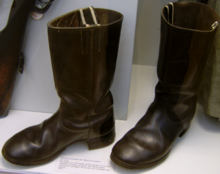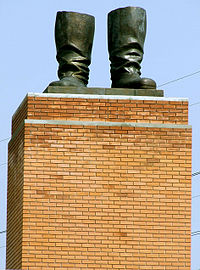- Jackboot
-
The term Jackboot denotes two very different styles of military boot, the Cavalry Jackboot and the Hobnailed Jackboot, and its derivatives.
Contents
Cavalry Jackboot
The term originally denoted tall winged leather cavalry boots, which had been "jacked" or reinforced against sword blows by use of chain mail sewn into the lining of the leather.[1] The wings on these high boots particularly protected a rider's knee-joint from a sword blow. These boots are still worn and still so termed by the Household Cavalry Regiment of the British Army, founded in the 17th century. The term originates from the French word Jaque (m) meaning chainmail. The term is of Catalan origin, descended from the Arabic schakk.[2] These boots were made very heavy by the chain-mail reinforcement, and are slightly less so today from the use of modern materials as stiffeners. There are few manufacturers of Cavalry Jackboots extant in the 21st century, the most famous being Schnieder Boots[3] (pronounced Schneeder) of Mayfair, London, the official supplier to Her Majesty the Queen's Household Cavalry.
Hobnailed Jackboot
The second meaning of the term is derived from the first, with reference to their toughness, but is unrelated in design and function, being a combat boot designed for marching, rising to at least mid-calf, with no laces, typically a leather sole with hobnails, and heel irons.[4][5] The Germans call this boot "Marschstiefel", meaning "Marching Boot". This is the classic boot used by the German Infantry and the "Stormtroopers" in World War I, see image. An etymological source not derived from the Cavalry Jackboot has been suggested as from the word jack, jacket or jerkin, as a common garment worn by the peasantry.[6]
Although hobnailed short Jackboots date from before the Napoleon Bonaparte era, they became popular with the Germanic armies in the mid to late 19th century because of their perceived durability over "lesser" boots. Worn out boots were considered a major problem for armies on the march and the high quality leather "jackboot" with its hobnails was deemed to be more durable than the alternatives available. As Prussia and the associated German minor powers relied on quickly defeating its opponents before they could fully mobilize and coordinate, their infantry's ability to march long distances was obviously a major issue. The jackboot was replaced by lesser quality ankle boots in the German army when leather became scarce in WWII.
The jackboot is associated with authoritarian and totalitarian regimes and has become a motif of such. Some modern-day clothing and boot fetishists find the connection between the implied power and symbolism of the jackboot sexually arousing, and it forms a part of the fetishistic ideal of Nazi chic.
As an allegory
Totalitarianism
The word is commonly used in Britain as a synonym for totalitarianism, particularly fascism, although jackboots and similar types of footwear have been worn by various British regiments since the 18th century (see Wellington Boot, origins). Following the 1982 invasion of the Falkland Islands, British Prime Minister Margaret Thatcher declared that the democratic rights of the Falkland Islanders had been assaulted, and would not surrender the islands to the Argentine "jackboot."
In 1995, National Rifle Association (NRA) Executive Vice-president Wayne LaPierre sparked controversy when he referred to federal agents as "jackbooted government thugs"; the comment caused former U.S. President George H.W. Bush to cancel his lifetime membership in the organization. The resignation of so public a figure as Mr. Bush prompted an open letter from the association to the former president to be published in major newspapers; the letter included a litany of alleged and settled cases of Bureau of Alcohol, Tobacco and Firearms abuses and an assertion that LaPierre and the NRA were merely borrowing a well-worn phrase uttered by other public figures in their calls for reform of the agency, among them Representative John Dingell of Michigan.[7]
The boots are connected to fascism, particularly Nazism, as they were issued by the Wehrmacht and SS as part of the World War II German uniform before Germany encountered leather shortages. When goosestepping on pavement, the large columns of German soldiers in Marschstiefel ("marching boots") created a distinct rock-crushing sound which came to symbolize German conquest and occupation. A similar style of boot had been in use with German armies in World War I the Franco-Prussian War and before.
Jackboots can also be associated with the armies of the former USSR (called sapogi) and East Germany. Jackboots are still a part of the modern parade and service attire of the army of Russia and several other former Soviet states.
Oppression
The Russian expression "под сапогом" "under one's boot" translates as "under one's heel" and symbolizes oppression. The Spanish expression "tener (algo o alguien) bajo la bota" or "to have (something or somebody) under the boot" has the same meaning.
See also
- Thigh-length boots
- Riding boots
- Tom of Finland
References
- ^ Household Cavalry Uniforms - Boots. Householdcavalry.info. Retrieved on 2010-11-16.
- ^ Larousse Dictionnaire de la Langue Francaise, Lexis, Paris, 1993, "cotte de mailles"
- ^ Schnieder Boots
- ^ dress Colonial America - Britannica Online Encyclopedia
- ^ Shoes: their history in words and pictures By Charlotte Yue, David Yue ISBN 0395726670, p. 43
- ^ "Jack", 11th Edition of Encyclopedia Britannica
- ^ "revolution: nra vs bush". Boogieonline.com. http://www.boogieonline.com/revolution/firearms/enforce/nra_thug.html. Retrieved 2009-09-06.
Footwear Men's dress shoes Brogues · Derbies · Loafers · Court shoes · Monks · Oxfords · Spectator shoes (Co-respondent shoes) · Venetian style shoes · Winklepickers · Brothel creepersWomen's dress shoes Ballet flats · Court shoes (Pumps) · Loafers · Slingbacks · Mules · Mary Janes · Mojari · Saddle shoes · Venetian style shoes · WinklepickersOther shoes Clog · Espadrilles · Flip-flops · Galoshes · Geta · Giveh · Moccasins · Platform shoes · Sandals · Slides · Slippers · VeldskoensMilitary footwear Ammunition boots · Cold weather boots · Combat boots · Jackboots · Jump boots · Jungle boots · Tactical boots · Tanker boots · Trench bootsSport-related footwear Fashion boots Work boots/shoes Australian work boots · Chukka boot · Cowboy boot · Hip boot · Rigger boot · Steel toe boots · Waders · Engineer bootsOther boots Historical Categories:- Military uniforms
- Military boots
Wikimedia Foundation. 2010.





